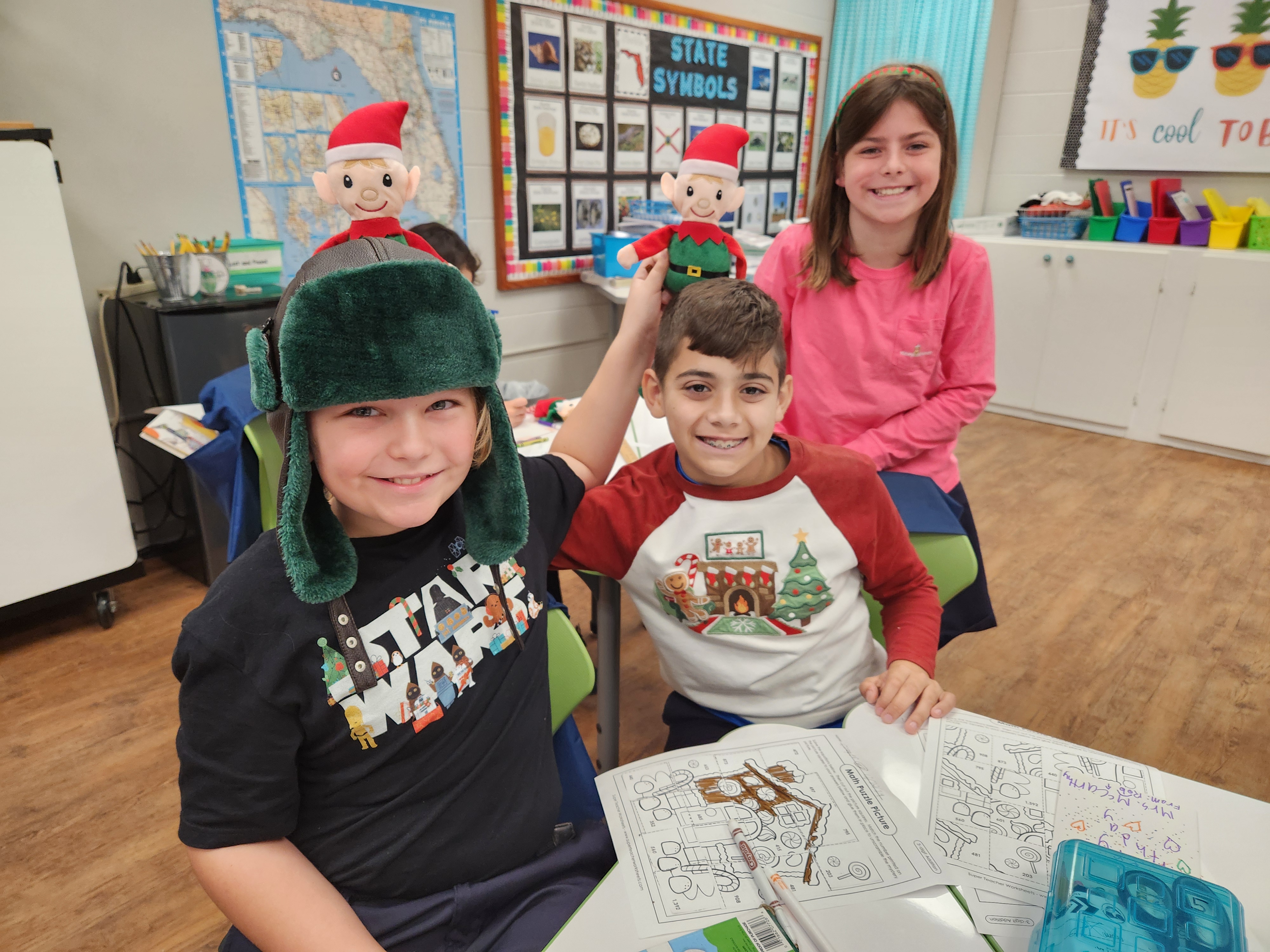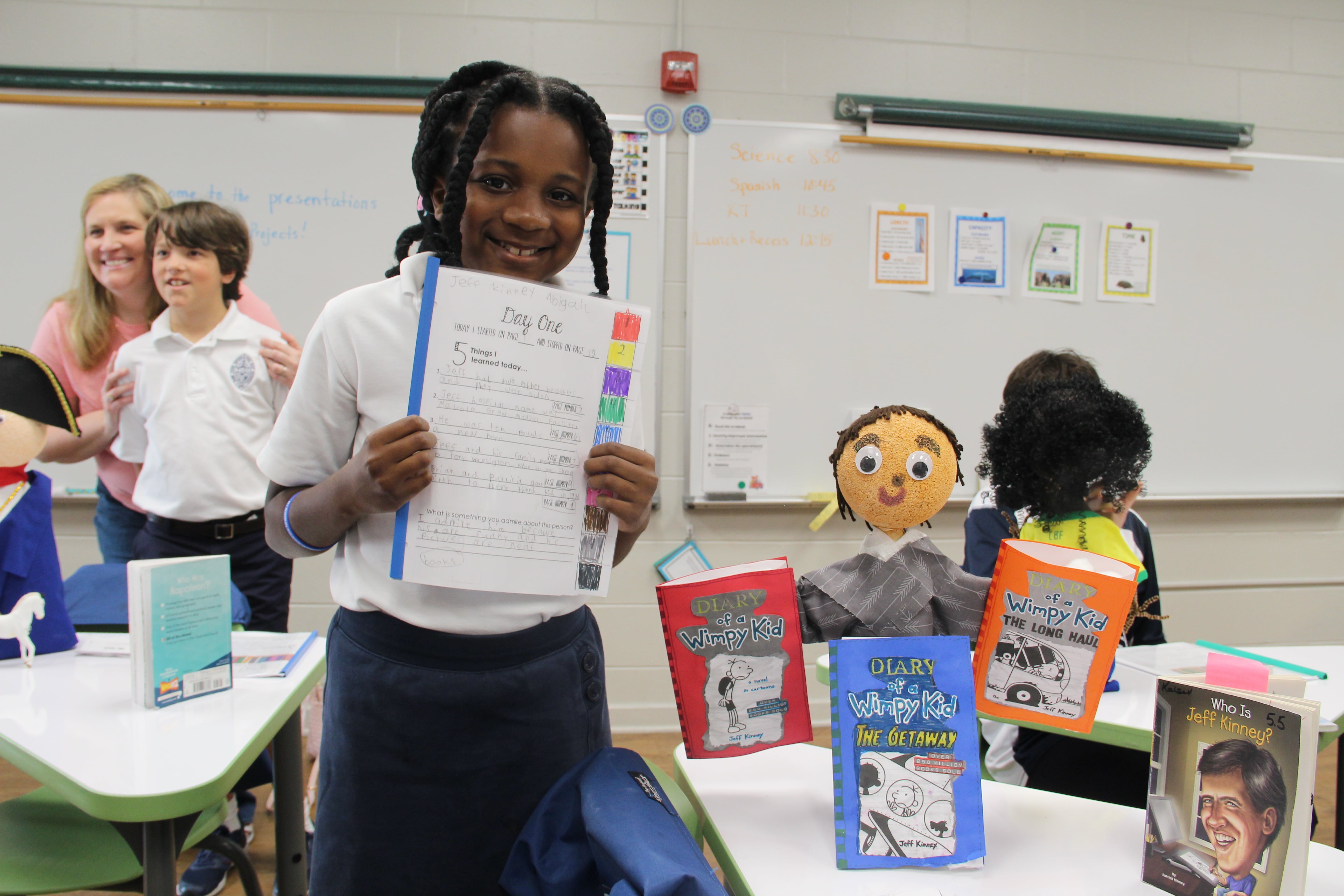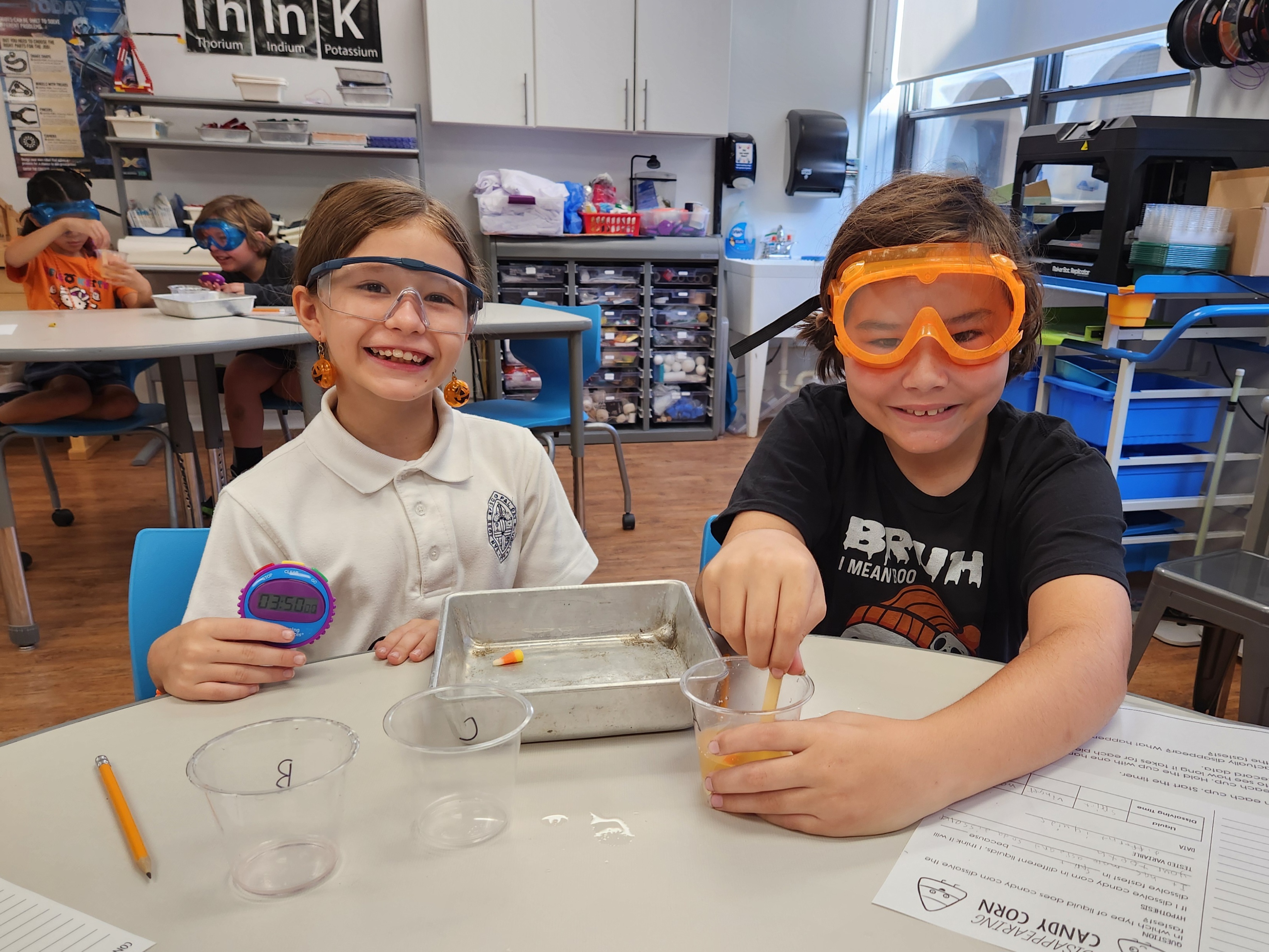
Fourth Grade Curriculum
Fourth grade is a year of remarkable growth in reading, writing, and critical thinking, as students engage with increasingly complex texts and learn to approach them with precision, confidence, and curiosity. They build fluency through expressive reading and apply advanced decoding strategies using word analysis, context clues, and Greek and Latin roots. In whole-class and small-group settings, students analyze literary elements such as setting, conflict, and character development to uncover plot and theme, explore figurative language and poetic structure, and distinguish between narrator and character perspectives. Through rich discussions and cross-curricular projects, they extract and summarize central ideas, evaluate text structures and authorial choices, and compare primary and secondary sources. These high-level comprehension tasks are paired with frequent writing opportunities across narrative, opinion, and expository genres, where students learn to plan, elaborate, and support their ideas using evidence from multiple sources.
Writing and communication come alive in fourth grade as students plan, draft, revise, and edit with intention and ownership. Whether composing stories with dialogue and vivid detail or constructing arguments with logical reasoning, they hone their skills through one-on-one conferences, peer feedback, and the use of digital tools. Cursive handwriting is practiced alongside grammar and spelling conventions, helping students communicate with both accuracy and style. From publishing essays with embedded multimedia to delivering oral presentations with academic vocabulary and visual support, our fourth graders grow into articulate thinkers, capable writers, and confident speakers prepared for the next stage of their academic journey.
At our school, fourth-grade students benefit from a departmentalized model that gives them access to expert instruction in each of the core academic areas—language arts, math, science, and social studies. This structure allows teachers to specialize in their subject, bringing depth, enthusiasm, and clarity to their instruction. At the same time, our faculty collaborates closely to design cross-curricular units of inquiry that make learning meaningful and integrated. Literacy is not confined to the language arts classroom—it weaves naturally through students’ experiences in science and social studies, reinforcing their reading, writing, and critical thinking skills across subjects.
In social studies, students explore Florida’s history, geography, and diverse cultures through engaging texts, primary sources, and rich discussions that sharpen their reading comprehension and analytical abilities. Their learning culminates in a memorable trip to St. Augustine, where they experience firsthand the places, people, and events they've studied—deepening both their historical understanding and their ability to communicate it through reflective writing and presentations. Similarly, in science, students undertake a cross-disciplinary exploration of Florida’s unique ecosystems and marine life, brought to life during an immersive trip to Crystal River. There, students study manatees and the environment they inhabit, extending their scientific research and writing skills in a real-world context. This integrated approach fosters a sense of purpose and connection in students’ literacy development.
Skills & Understandings:
- Decode unfamiliar words using grade‑level phonics, word analysis, Greek and Latin roots, affixes, and context clues
- Read grade‑level texts fluently—accurately, automatically, and with expressive prosody
- Analyze setting, events, conflict, and character development to explain plot, theme (stated or implied), and the difference between narrator point of view and character perspective
- Interpret how rhyme, poetic structure, and figurative language (metaphor, simile, etc.) build meaning in poetry and prose
- Determine the central idea or theme in literary and informational texts and explain how relevant details develop it
- Explain how text features and structures—problem/solution, sequence, description—support comprehension and meaning
- Evaluate an author’s perspective, claims, and supporting reasons or evidence, and compare primary vs. secondary accounts of the same event
- Summarize texts concisely, including plot and theme for literature or central idea and key details for informational texts
- Conduct research to answer questions, organizing information gathered from multiple valid sources
- Write legibly in cursive and apply grade‑level grammar, punctuation, capitalization, and spelling conventions
- Craft personal or fictional narratives with logical sequence, rich description, dialogue, and effective transitions
- Compose opinion/argument pieces that present a clear claim supported by logical reasons, evidence, elaboration, and cohesive organization
- Develop expository texts drawing on multiple sources, elaborating ideas, and using clear transitions and structure
- Improve writing by planning, drafting, revising, and editing—individually or collaboratively—using digital tools and peer and/or adult feedback
- Present ideas orally with clear pronunciation, appropriate volume, non‑verbal cues, multimedia enhancements, and precise academic vocabulary
- Use digital tools to plan, draft, revise, and enhance both written and oral tasks with appropriate multimedia elements
In fourth grade, students make exciting strides in mathematical understanding as they begin to work confidently with multi-digit numbers and deepen their grasp of place value, including numbers with decimals. They strengthen their skills in all four operations (addition, subtraction, multiplication, and division) and apply them to increasingly complex problems involving both whole numbers and fractions. Students develop a strong sense of equality and begin to recognize and extend numerical patterns, learning to work with rules and relationships that help make sense of the math around them. Their understanding of fractions expands as they explore how different fractions relate to one another and decimals, and they build a solid foundation in adding, subtracting, and multiplying fractions. In measurement, students solve real-world problems involving time, money, length, perimeter, and area, while also learning to draw, measure, and classify angles with precision. In geometry, they investigate the properties of shapes and apply their understanding to solve practical problems. Through data analysis, students learn to collect, represent, and interpret data sets, using measures like mode, median, and range to draw conclusions. By year’s end, fourth graders are thinking more flexibly and abstractly, applying their growing toolkit of strategies to solve problems with confidence and precision.
Skills & Understandings:
- Understand place value for multi-digit numbers
- Build an understanding of operations with multi-digit numbers, including decimals
- Represent and solve problems involving the four operations with whole numbers and fractions
- Demonstrate an understanding of equality and operations with whole numbers
- Recognize numerical patterns, including patterns that follow a given rule
- Measure the length of objects and solve problems involving measurement
- Solve problems involving time and money
- Develop an understanding of the relationship between different fractions and the relationship between fractions and decimals
- Build a foundation of addition, subtraction, and multiplication operations with fractions
- Draw, classify, and measure angles
- Solve problems involving the perimeter and area of rectangles
- Collect, represent, and interpret data and find the mode, median, and range of a data set
In fourth grade science, students embark on an inspiring journey of discovery that deepens their understanding of the natural world and ignites a lifelong curiosity. They explore the incredible diversity of living organisms, learning how life is organized and how species evolve. Through studying interdependence, students gain insight into the complex relationships that connect all living things and their environments. In physical science, they investigate the properties and changes of matter, uncovering the many forms of energy and how energy moves and transforms around us. Their exploration extends to Earth and space science, where they study Earth’s place in the vast universe, examine the dynamic structures of our planet, and develop a keen appreciation for the forces shaping our world. Throughout the year, students engage in the authentic practice of science—using models, asking questions, and conducting experiments—building critical thinking skills and a scientific mindset. This rich, hands-on learning experience equips fourth graders to become thoughtful observers and problem solvers, ready to understand and protect the world they live in.
Skills & Understandings:
- Ask scientifically relevant questions and define problems
- Develop and use models to represent ideas
- Plan and carry out investigations using hands-on experiments
- Analyze and interpret data from observations, measurements, charts, or maps
- Construct explanations based on evidence and engage in argument from evidence
- Design and test solutions to real-world problems
- Investigate how motion is affected by forces such as friction, gravity, and applied pushes/pulls
- Identify familiar physical and chemical changes in materials
- Describe the properties of matter (mass, volume, hardness, texture, color, odor, magnetism) and classify materials accordingly
- Recognize physical weathering vs. erosion and describe how wind, water, ice, plants, and temperature act upon rocks
- Identify and compare physical properties and common uses of water in its three states
- Observe and describe physical properties of earth-forming minerals (hardness, luster, color, streak) and their role in rock formation
- Explain how plants and animals have internal and external structures that support their survival, growth, behavior, and reproduction
- Use models to show how animals sense and respond to information from their environment
- Integrate science, engineering, and technology to solve problems and design solutions
- Apply ideas of systems, stability, and change when exploring natural phenomena
- Recognize and interpret patterns in natural systems—like layering of rocks, wave patterns, water cycle, or animal structures
Fourth grade is an exciting and intellectually rich year in social studies, as students dive deep into the dynamic story of Florida—its people, its past, and its place in the broader world. Through the careful analysis of primary and secondary sources, students explore key individuals and pivotal events that have shaped Florida’s identity. They investigate the lives of Native American tribes, examine the arrival of European explorers, and uncover the complex consequences of colonization, including the formation of the Seminole tribe and the struggles of Native peoples. Students learn about Florida’s earliest European settlement in St. Augustine, the missions that shaped early life, and the founding of Fort Mose, the first free African community in the United States. As they trace Florida’s path to becoming a U.S. territory, they analyze the Seminole Wars, study the effects of Spanish rule, and explore how immigrants and entrepreneurs built vibrant communities across the state.
Throughout the year, students develop geographic literacy by labeling maps, identifying Florida’s physical and cultural features, and understanding how climate and weather affect life here. They also examine how advances in technology—from railroads to the space program—have transformed Florida’s economy and population growth. Students trace economic cycles from the land boom of the 1920s to the Great Depression, and they study how tourism, agriculture, and aerospace continue to fuel the state’s economy today. They consider Florida’s role in national events such as the Spanish-American War and the Civil Rights Movement, and they reflect on the lasting contributions of African American leaders and immigrant communities.
In civics, students explore how Florida’s government is structured and how citizens participate through voting, public service, and working together to solve problems. They identify current state leaders and compare the roles of local and state governments. As part of their financial literacy learning, students are introduced to real-world concepts such as budgeting, saving, investing, and the responsible use of credit. They learn how interest works, how to plan for emergencies, and how individuals make choices to manage risk. This comprehensive and rigorous program equips fourth graders with a deep understanding of Florida’s history, a strong sense of civic responsibility, and the tools to make thoughtful economic decisions, laying a powerful foundation for lifelong learning and engaged citizenship.
Skills & Understandings:
- Explore Florida’s history by using primary and secondary sources, books, and digital tools
- Learn about Florida’s Native American tribes and how their lives changed with the arrival of the Spanish, French, and English explorers and colonizers
- Learn how the Seminole tribe formed and the causes and effects of the Seminole Wars
- Examine the challenges Floridians faced during Reconstruction, the Great Depression, and after the wars
- Learn about Florida’s economic growth through industries like agriculture, tourism, and space exploration
- Discover how immigration—past and present—has shaped Florida’s culture and economy
- Explore Florida’s role in the Civil Rights Movement and learn about influential African American leaders
- Use maps to locate the physical and cultural features of Florida and understand how weather affects the state
- Understand how citizens can work with local and state governments to solve problems in their communities
- Learn about the structure and roles of Florida’s three branches of government and elected officials
- Understand the importance of voting, volunteering, and participating in civic life
- Learn the basics of earning, saving, spending, and paying taxes
- Understand how credit, interest, and investing help people manage money and plan for the future
Schedule a Tour
Come see for yourself why SJEDS is an investment in a brighter future.









.avif)